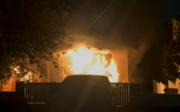Cheap country homes face rising risk as insurance vanishes in key areas
By
Gian T
- Replies 4
Dreaming of a tree change? You’re not alone. With city house prices soaring and remote work more common than ever, many Aussies—especially those of us looking for a quieter, more affordable lifestyle—are eyeing regional towns for their next move.
But before you pack up the car and head for greener pastures, there’s a crucial warning you need to hear: that 'bargain' country home could soon be uninsurable, leaving you exposed to massive financial risk.
It’s no secret that Australia’s climate is getting wilder. From bushfires to floods, natural disasters are hitting regional areas with increasing frequency and severity.
Just last month, 16 local government areas in the NSW Hunter and Mid-North Coast were declared natural disaster zones after catastrophic floods.
Over 6,000 insurance claims were lodged—80 per cent for damaged homes.
The Climate Council warns that up to half the homes in these areas are at moderate to high risk of being affected by a natural disaster.
This isn’t just a short-term headache. As the risk of disaster rises, so do insurance premiums. In some high-risk areas, annual home insurance can now top $30,000—a figure that’s simply out of reach for most average-income earners.
In fact, of Australia’s 10 most disaster-prone zones, seven are in regional areas. That means the very places that attract new residents with their affordable property prices could soon become impossible to insure.
If you’re considering a move, it pays to know which areas are most at risk.
In NSW, five regional areas north of Sydney are flagged as high-risk, along with parts of northern Victoria, southern Queensland, and areas around Brisbane, Adelaide, and Perth.
Let’s look at some of the most popular regional hotspots:
You might think, 'I’ll just pay a bit more for insurance.' But in some areas, it’s not just about cost. 'Uninsurable' means premiums are so high that the average person simply can’t afford them—or insurers have stopped offering cover altogether.
Sometimes, you might be able to get basic home and contents insurance, but not for specific risks like flood or fire. That leaves you dangerously exposed if disaster strikes.
It’s easy to see why people are drawn to these areas: the property is cheap, the lifestyle is appealing, and the scenery is stunning.
But as natural disasters become more frequent, the risk to your investment grows.
If insurance becomes unaffordable or unavailable, property values could plummet even further.
And if you’re thinking of 'taking on the risk yourself,' remember that a single flood or fire could wipe out your savings—and your home.
Economist Nicki Hutley from the Climate Council says it’s not always a simple 'don’t move there' message.
In some cases, community infrastructure—like levees, flood barriers, and bushfire mitigation—can significantly reduce risk.
But these solutions are expensive and not always available, especially in smaller towns.
If you’re set on a regional move, do your homework. Check flood maps, bushfire risk ratings, and local council plans for disaster mitigation.
Talk to insurers before you buy to see what cover is available and at what cost.
And if you’re looking at a home near a river or in a bushfire-prone area, factor in the cost of raising the house or making other modifications to protect your investment.
Don’t let a cheap price tag blind you to the risks. Take the time to research, ask questions, and make sure you can protect your new home for years to come.

Have you made the move to the country, or are you thinking about it? Have you struggled to get insurance or been shocked by the cost? Share your experiences and tips in the comments below.
Read more: You won’t believe what’s growing in homes after the floods
But before you pack up the car and head for greener pastures, there’s a crucial warning you need to hear: that 'bargain' country home could soon be uninsurable, leaving you exposed to massive financial risk.
It’s no secret that Australia’s climate is getting wilder. From bushfires to floods, natural disasters are hitting regional areas with increasing frequency and severity.
Just last month, 16 local government areas in the NSW Hunter and Mid-North Coast were declared natural disaster zones after catastrophic floods.
Over 6,000 insurance claims were lodged—80 per cent for damaged homes.
The Climate Council warns that up to half the homes in these areas are at moderate to high risk of being affected by a natural disaster.
This isn’t just a short-term headache. As the risk of disaster rises, so do insurance premiums. In some high-risk areas, annual home insurance can now top $30,000—a figure that’s simply out of reach for most average-income earners.
In fact, of Australia’s 10 most disaster-prone zones, seven are in regional areas. That means the very places that attract new residents with their affordable property prices could soon become impossible to insure.
If you’re considering a move, it pays to know which areas are most at risk.
In NSW, five regional areas north of Sydney are flagged as high-risk, along with parts of northern Victoria, southern Queensland, and areas around Brisbane, Adelaide, and Perth.
Let’s look at some of the most popular regional hotspots:
- Maitland (NSW Hunter Valley): Australia’s fifth most popular area for internal migration, but nearly half of homes are at moderate to high risk of natural disasters.
- Mid-Coast (Taree): Recently hit by 500mm of rain in just four days, with 45.7 per cent of homes at risk.
- Port Macquarie: Eighth on the list for relocators, but a whopping 57.2 per cent of homes are at risk of climate hazards.
- Tweed (NSW Far North Coast): 47 per cent of properties are at risk, with nearly 29 per cent at high risk.
- Shoalhaven (NSW South Coast): Seventh most popular for movers, with 36.9 per cent of properties at risk.
- Lismore: After devastating floods, the median house price is just $472,923 (less than half the national average), but over half the properties are at risk
You might think, 'I’ll just pay a bit more for insurance.' But in some areas, it’s not just about cost. 'Uninsurable' means premiums are so high that the average person simply can’t afford them—or insurers have stopped offering cover altogether.
Sometimes, you might be able to get basic home and contents insurance, but not for specific risks like flood or fire. That leaves you dangerously exposed if disaster strikes.
It’s easy to see why people are drawn to these areas: the property is cheap, the lifestyle is appealing, and the scenery is stunning.
If insurance becomes unaffordable or unavailable, property values could plummet even further.
And if you’re thinking of 'taking on the risk yourself,' remember that a single flood or fire could wipe out your savings—and your home.
Economist Nicki Hutley from the Climate Council says it’s not always a simple 'don’t move there' message.
In some cases, community infrastructure—like levees, flood barriers, and bushfire mitigation—can significantly reduce risk.
But these solutions are expensive and not always available, especially in smaller towns.
Talk to insurers before you buy to see what cover is available and at what cost.
And if you’re looking at a home near a river or in a bushfire-prone area, factor in the cost of raising the house or making other modifications to protect your investment.
- Research the area’s disaster history and risk profile.
- Get insurance quotes before you sign anything.
- Ask the local council about flood and fire mitigation measures.
- Consider the long-term impact on property value and resale.
- Be realistic about your ability to pay for repairs or rebuild if disaster strikes.
Don’t let a cheap price tag blind you to the risks. Take the time to research, ask questions, and make sure you can protect your new home for years to come.
Key Takeaways
- Prospective buyers of affordable country homes in regional Australia are being warned that many areas are becoming uninsurable due to increasing risks of floods and bushfires.
- Insurance premiums in high-risk regional hotspots are rising to unaffordable levels, with some homeowners facing annual costs as high as $30,000—or being unable to obtain cover for floods or fires at all.
- Data shows that seven out of Australia's ten most disaster-prone zones are in regional areas, with places like Maitland, Taree, Port Macquarie, and Lismore seeing a majority of homes at moderate to high risk from climate hazards.
- Experts urge anyone considering a move to the region to carefully check the natural disaster risk and insurance situation before buying, as climate change is making extreme events more frequent and property values in affected areas could suffer further.
Read more: You won’t believe what’s growing in homes after the floods
Last edited:








